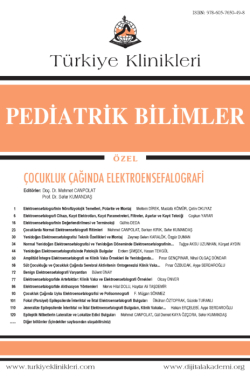Technical Considerations and Montage of Neonatal Electroencephalography
Zeynep Selen KARALÖKa, Özgür DUMANb
aÇocuk Nörolojisi Kliniği, Ankara Çocuk Sağlığı ve Hastalıkları Hematoloji Onkoloji Eğitim ve Araştırma Hastanesi, Ankara, TÜRKİYE
bÇocuk Nörolojisi BD, Akdeniz Üniversitesi Tıp Fakültesi, Antalya, TÜRKİYE
Karalök ZS, Duman Ö. Yenidoğan elektroensefalografisi teknik özellikleri ve montaj. Canpolat M, Kumandaş S, editörler. Çocukluk Çağında Elektroensefalografi. 1. Baskı. Ankara: Türkiye Klinikleri; 2019. p.30-3.
ABSTRACT
In the neonatal period, brain development is quite open to external influences. One of the effective monitoring methods of this period is the neonatal EEG. It provides important information about both seizures and prognosis. However, the neonatal EEG has difficulties due to the structural composition of the infant head as well as the equipment used. In this section, the technical characteristics of the neonatal EEG, neonatal montage systems, and EEG recording aspects will be discussed.
Keywords: Electroencephalography; montage; technique; newborn
Kaynak Göster
Referanslar
- Palva S, Palva JM. Discovering oscillatory interaction networks withM/EEG: challenges and breakthroughs. Trends Cogn Sci. 2012;16(4):219-30. [Crossref] [PubMed]
- Tadic BV, Kravljanac R, Sretenovic V, Vukomanovic V. Long-term outcome in children with neonatal seizures: a tertiary center experience in cohort of 168 patients. Epilepsy Behav. 2018;84:107-13. [Crossref] [PubMed]
- Vanhatalo S, Kaila K. Development of neonatal EEG activity: from phenomenology to physiology. Semin Fetal Neonatal Med. 2006;11(6):471-8. [Crossref] [PubMed]
- Clancy RR, Sharif U, Ichord R, Spray TL, Nicolson S, Tabbutt S, et al. Electrographic neonatal seizures after infant heart surgery. Epilepsia. 2005;46(1):84-90. [Crossref] [PubMed]
- Eriksson M, Zetterström R. Neonatal convulsions. Incidence and causes in the Stockholm area. Acta Paediatr Scand. 1979;68(6):807-11. [Crossref] [PubMed]
- Gluckman PD, Wyatt JS, Azzopardi D, Ballard R, Edwards AD, Ferriero DM, et al. Selective head cooling with mild systemic hypothermia after neonatal encephalopathy: multicentre randomised trial. Lancet. 2005;365(9460):663-70. [Crossref] [PubMed]
- Lanska MJ, Lanska DJ, Baumann RJ, Kryscio RJ. A population-based study of neonatal seizures in Fayette County, Kentucky. Neurology. 1995;45(4):724-32. [Crossref] [PubMed]
- Ronen GM, Penney S, Andrews W. The epidemiology of clinical neonatal seizures in Newfoundland: a population-based study. J Pediatr. 1999;134(1):71-5. [Crossref] [PubMed]
- Saliba RM, Annegers FJ, Waller DK, Tyson JE, Mizrahi EM. Incidence of neonatal seizures in Harris County, Texas, 1992-1994. Am J Epidemiol. 1999;150(7):763-9. [Crossref] [PubMed]
- Clancy RR, Legido A, Lewis D. Occult neonatal seizures. Epilepsia. 1988;29(3):256-61. [Crossref] [PubMed]
- Murray DM, Boylan GB, Ali I, Ryan CA, Murphy BP, Connolly S. Defining the gap between electrographic seizure burden, clinical expression and staff recognition of neonatal seizures. Arch Dis Child Fetal Neonatal Ed. 2008;93(3):F187-91. [Crossref] [PubMed]
- Silverstein FS, Ferriero DM. Off-label use of antiepileptic drugs for the treatment of neonatal seizures. Pediatr Neurol. 2008;39(2):77-9. [Crossref] [PubMed]
- Elshorbagy HH, Azab AA, Barseem NF, Bassiouny MM, Elsayed MA, Elkhouly TH. Value of electroencephalographic monitoring in newborns with hypoxicischemic encephalopathy treated with hypothermi. J Pediatr Neurosci. 2016;11(4):309-15. [Crossref] [PubMed] [PMC]
- Shellhaas RA, Chang T, Tsuchida T, Scher MS, Riviello JJ, Abend NS, et al. The American Clinical Neurophysiology Society's guideline on continuous electroencephalographymonitoring in neonates. J Clin Neurophysiol. 2011;28(6):611-7. [Crossref] [PubMed]
- Nunes ML, Da Costa JC, Moura-Ribeiro MV. Polysomnographic quantification of bioelectrical maturation in preterm and fullterm newborns at matched conceptional ages. Electroencephalogr Clin Neurophysiol. 1997;102(3):186-91. [Crossref] [PubMed]
- Shany E, Berger I. Neonatal electroencephalography: review of a practical approach. J Child Neurol. 2011;26(3):341-55. [Crossref] [PubMed]
- Shellhaas RA, Chang T, Tsuchida T, Scher MS, Riviello JJ, Abend NS, et al. The American Clinical Neurophysiology Society's guideline on continuous electroencephalography monitoring in neonates. J Clin Neurophysiol. 2011;28(6):611-7. [Crossref] [PubMed]
- Epstein CM. Guidelines 2: minimum technical standards for pediatric electroencephalography. J Clin Neurophysiol. 2006;23(2):92-6. [Crossref] [PubMed]
- Kuratani J, Pearl PL, Sullivan L, Riel-Romero RM, Cheek J, Stecker M, et al. American Clinical Neurophysiology Society Guideline 5: minimum technical standards for pediatric electroencephalography. J Clin Neurophysiol. 2016;33(4):320-3. [Crossref] [PubMed]
- Laroia N, Guillet R, Burchfiel J, McBride MC. EEG background as predictor of electrographic seizures in high-risk neonates. Epilepsia. 1998;39(5):545-51. [Crossref] [PubMed]
- Gluckman PD, Wyatt JS, Azzopardi D, Ballard R, Edwards AD, Ferriero DM, et al. Selective head cooling with mild systemic hypothermia after neonatal encephalopathy: multicentre randomised trial. Lancet. 2005;365(9460):663-70. [Crossref]
- Nash KB, Bonifacio SL, Glass HC, Sullivan JE, Barkovich AJ, Ferriero DM, et al. Video-EEG monitoring in newborns with hypoxic-ischemic encelphalopathy treated with hypothermia. Neurology. 2011;76(6):556-62. [Crossref] [PubMed] [PMC]
- Clancy RR, Sharif U, Ichord R, Spray TL, Nicolson S, Tabbutt S, et al. Electrographic neonatal seizures after infant heart surgery. Epilepsia. 2005;46(1):84-90. [Crossref] [PubMed]

